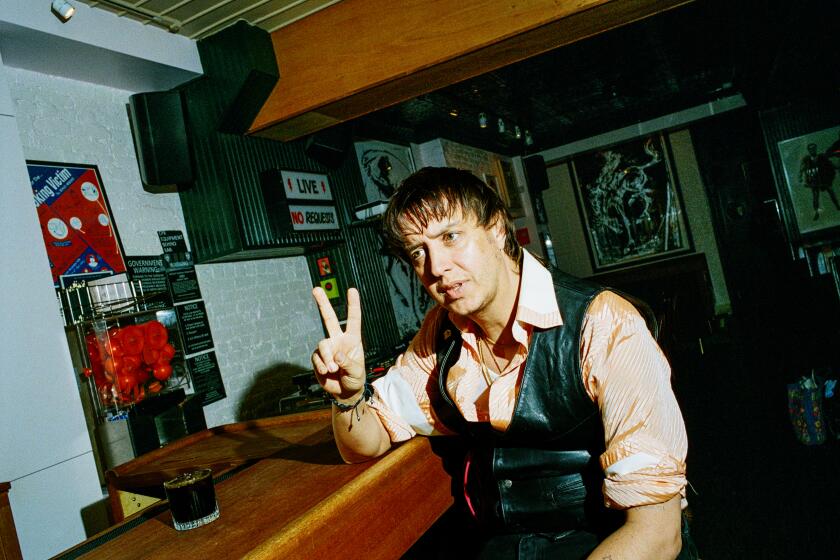Agreement Reached for Custody of Jerry Garcia’s Guitars
SAN FRANCISCO — A long-standing custody fight over the famed guitars of the late Grateful Dead lead-man Jerry Garcia finally ended Monday, setting the stage for an auction of a storied--and intensely coveted--piece of rock history.
After nearly a year of on-again, off-again litigation, lawyers announced that they had reached agreement on the ownership of the five instruments that had been handmade for Garcia by Bay Area luthier Doug Irwin, and then bequeathed back to their maker.
Under the agreement, two of the best-known guitars--nicknamed Wolf and Tiger for the shapes of their intricate inlays--will revert to Irwin, and two will stay with the Dead, which had argued that the instruments had been communally owned and not Garcia’s to will away.
The fate of the fifth guitar is unclear. It is believed to have been given away by Garcia to a member of the original Dead crew named Ramrod, but lawyers on both sides say they have received conflicting stories about its whereabouts. In any case, experts say, of the five guitars, it was the one Garcia least played and thus the least valuable.
Lawrence K. Rockwell, the Dead’s attorney, said the band is “happy that the matter is resolved” and ready to get on with the deal’s execution. Garcia’s bandmates have said they hope to make their instruments, known as Rosebud and Headless, a key display at Terrapin Station, a San Francisco museum they have long planned to open.
Irwin, who has been destitute since he was nearly killed in a hit-and-run accident three years ago, says he will keep Wolf, which he custom-made for Garcia and sold to him for $1,500 in 1973. But, he said, he will immediately put Tiger up for auction. The latter guitar, which Irwin spent more than six years crafting out of coca-bola, maple, mother-of-pearl and vermilion, was Garcia’s signature instrument, and he played it almost daily for 11 years.
“Yeah, I had to hold my nose, but I signed the deal,” said Irwin, whose insistence that the Dead had failed Garcia’s memory by not handing over all five guitars had been the main obstacle to settlement. Irwin and the band had been friendly for decades. Self-taught in a 1960s welfare-to-work program, he had developed his craft to the point that his clients included such guitar greats as Neil Young and Carlos Santana. He was so close to Garcia that the return of the Irwin guitars was Garcia’s sole bequest to a non-family member, although the musician’s lawyers misspelled Irwin’s name in the will.
But after Garcia’s death and Irwin’s reversals of fortune, his relationship with the Dead deteriorated badly, with Irwin claiming that the Dead had reproduced his signature guitar designs without paying him royalties. Sources close to the band members said that he would occasionally burst into their offices, angrily ranting, but that the relationship was also a moral dilemma for them. Irwin, by this year, was so down on his luck that he couldn’t afford to get his woodworking equipment out of storage and was living with his elderly mother in Hemet.
His situation--and the confusion of legions of Deadheads, who followed the case avidly on the Internet, pitted the band’s reputation for loyalty and philanthropy against their communal principals.
The two sides had neared agreement in October, but Irwin had withdrawn his approval when the Dead asked that he not publicly disparage the agreement. He also objected to a clause that would have given the Dead first right of refusal if he put any of the guitars up for sale. That clause was removed from the final agreement--a move applauded by memorabilia experts, who said it would have significantly inhibited bidding, even with the cult-like devotion Garcia inspired in his fans.
“Nobody wants to commit to spending a lot of money just to find they aren’t going to get what they bid on,” said Steve Routhier, a Florida collectibles consultant who, as a vice president for Hard Rock Cafe International from 1986 to 1996, built that restaurant chain’s famed memorabilia collection.
“With [the clause] out of the way . . . it could be very competitive. Very competitive. With Jerry’s popularity and the fiendish following that the Dead has and the fact that lots of their hard-core fans are now wealthy--the Executive Deadheads, we used to call them--I wouldn’t be surprised if the bidding went into the high six figures.”
In 1990, a white acoustic guitar that had belonged to Buddy Holly--estimated by Sotheby’s to be worth $20,000--was sold for $249,500 to Gary Busey, the actor who had once played him. The white Stratocaster that Jimi Hendrix played at Woodstock, now in the Seattle rock museum of Microsoft co-founder Paul Allen, was bought by an Italian collector for $325,000. In 1999, John Lennon’s acoustic guitar fetched 140,000 pounds, or about $201,530. The same year, Eric Clapton’s “Brownie,” the tobacco-burst Stratocaster he played when he recorded “Layla,” set the record for rock guitars, selling for $450,000.
The hot market of the 1990s has softened along with the economy, experts say, but values have held firm for items of proven worth and solid provenance. Irwin’s lawyer said in October that a Connecticut collector who had read about the court fight offered $200,000 just for Wolf.
Last week, an electric guitar billed as a “Doug Erwin Guitar Made for Grateful Dead” was put up for auction on EBay, with bidding set at $20,000. The item was removed Monday after Irwin’s lawyer, Doug Long, questioned its authenticity to EBay, which directed him to the seller, a 32-year-old recording engineer from Chico named Brian Asher.
“We didn’t mean any disrespect or any kind of infringement,” said Asher, who described himself in an e-mail to Long as an “old-school S.F. head Sufi mystic rocker” whose band had once opened for the Jerry Garcia Band in San Francisco.
Asher said he had put the guitar up for auction at the behest of a friend who had been told by a one-time employee of Garcia that Irwin might have made it.
“It’s just an extremely high-quality instrument with an incredible neck. We just wanted to create some buzz.”
More to Read
The biggest entertainment stories
Get our big stories about Hollywood, film, television, music, arts, culture and more right in your inbox as soon as they publish.
You may occasionally receive promotional content from the Los Angeles Times.









